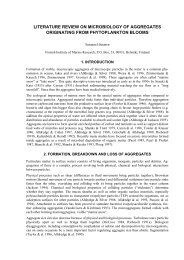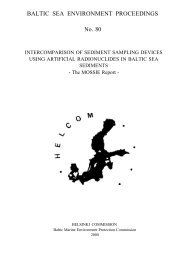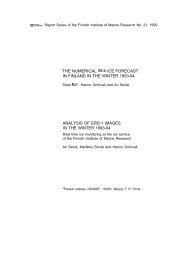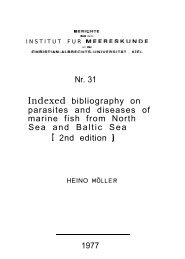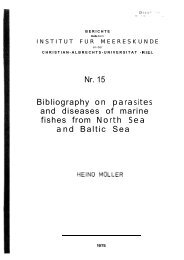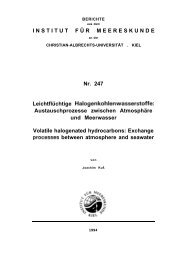marine research in finland - Baltic Marine Environment Bibliography
marine research in finland - Baltic Marine Environment Bibliography
marine research in finland - Baltic Marine Environment Bibliography
Create successful ePaper yourself
Turn your PDF publications into a flip-book with our unique Google optimized e-Paper software.
the <strong>Baltic</strong> <strong>in</strong> general. Professor Niemi stated that the general nutrient level <strong>in</strong> the Gulf of F<strong>in</strong>land<br />
has <strong>in</strong>creased dur<strong>in</strong>g this period, but that it is difficult to po<strong>in</strong>t out any s<strong>in</strong>gle source. Director<br />
Malkki po<strong>in</strong>ted out that although the St. Petersburg dam is often blamed for the eutrophication<br />
of the Gulf of F<strong>in</strong>land, it actually has no such effect. The construction of the dam co<strong>in</strong>cided with<br />
glasnost, hence the environmental problems <strong>in</strong> the Kronstadt area became the first environmental<br />
problems openly discussed <strong>in</strong> the former Soviet Union. Today, the floodgates of the dam are big<br />
enough to allow unrestricted flow. It is actually silt from the dredg<strong>in</strong>g of the St. Petersburg fairways<br />
that <strong>in</strong>hibits primary production <strong>in</strong>side the dam. The eutrophication caused by the nutrient<br />
load<strong>in</strong>g brought down by the river Neva therefore starts outside the dam, and high nutrient parameters<br />
are found practically throughout the Gulf of F<strong>in</strong>land, as stated by Pentti Kangas from<br />
the F<strong>in</strong>nish <strong>Environment</strong> Institute.<br />
In general, new k<strong>in</strong>ds of monitor<strong>in</strong>g strategies have been contemplated directed towards <strong>in</strong>tensive<br />
local monitor<strong>in</strong>g. Offshore monitor<strong>in</strong>g data can be obta<strong>in</strong>ed for the Hels<strong>in</strong>ki Commission by<br />
means of remote sens<strong>in</strong>g and automatic sampl<strong>in</strong>g systems. The far-reach<strong>in</strong>g consequences of<br />
political decisions were also po<strong>in</strong>ted out. If a certa<strong>in</strong> amount of money is <strong>in</strong>vested <strong>in</strong> F<strong>in</strong>land for<br />
nutrient removal and purification of water runn<strong>in</strong>g <strong>in</strong>to the Gulf of F<strong>in</strong>land, the environmental<br />
condition of coastal waters will improve. But if the same money is <strong>in</strong>vested <strong>in</strong> the St. Petersburg<br />
sewage water nutrient removal and purification, the condition of the whole of the Gulf of F<strong>in</strong>land<br />
will improve.<br />
The costs of monitor<strong>in</strong>g, especially to the universities, evoked discussion. Universities, especially<br />
biological stations, have <strong>in</strong>creas<strong>in</strong>gly participated <strong>in</strong> the monitor<strong>in</strong>g of the <strong>mar<strong>in</strong>e</strong> environment.<br />
Basic <strong>research</strong> is necessary to understand the processes beh<strong>in</strong>d environmental changes,<br />
such as sal<strong>in</strong>e water <strong>in</strong>flows <strong>in</strong>to the <strong>Baltic</strong>, and climate change. In contrast to the <strong>in</strong>creased task<br />
load<strong>in</strong>g to both <strong>research</strong> <strong>in</strong>stitutions and universities <strong>in</strong> the form of <strong>in</strong>creased environmental<br />
monitor<strong>in</strong>g, resources have dim<strong>in</strong>ished and cont<strong>in</strong>ue to decrease due to economical recession.<br />
Demands regard<strong>in</strong>g responsibility for results are be<strong>in</strong>g <strong>in</strong>creased, and all services the <strong>research</strong><br />
<strong>in</strong>stitutions and biological stations of universities perform should be priced accord<strong>in</strong>g to issued<br />
directions. However, the users of these services, mostly other state-operated <strong>in</strong>stitutions, have<br />
the same problem of decreased budgets, and cannot afford these prices, as director Jouko Pokki<br />
from the Tvlrm<strong>in</strong>ne Zoological Station (Hels<strong>in</strong>ki University) po<strong>in</strong>ted out. As a result, monitor<strong>in</strong>g<br />
is be<strong>in</strong>g carried out anyway on resources that are already stretched very th<strong>in</strong>, but how long<br />
can this go on? The conclusion of this discussion was that the M<strong>in</strong>istry of the <strong>Environment</strong><br />
should realize the <strong>in</strong>creased monitor<strong>in</strong>g obligations to <strong>research</strong> <strong>in</strong>stitutes and universities, and<br />
supply adequate resources so that the <strong>in</strong>stitutions responsible for the <strong>in</strong>creased monitor<strong>in</strong>g tasks<br />
can make both ends meet.<br />
Problems concern<strong>in</strong>g forecast<strong>in</strong>g are connected to the topics discussed above. It was suggested<br />
that forecast<strong>in</strong>g is closely connected with the environmental condition of the Gulf of F<strong>in</strong>land.<br />
The biggest challenge there <strong>in</strong> the forecast<strong>in</strong>g of the environmental development is the coupl<strong>in</strong>g<br />
of hydrodynamic and ecological models. The biggest problem <strong>in</strong> this seems to be the difference<br />
<strong>in</strong> time scales. Another problem <strong>in</strong> forecast<strong>in</strong>g is that forecasts, and the development of forecast<strong>in</strong>g<br />
for any <strong>mar<strong>in</strong>e</strong> parameters, can only be produced if a customer can be found, i.e. some <strong>in</strong>stance<br />
that is will<strong>in</strong>g to pay for the forecast, due to the meagre resources of the <strong>research</strong> <strong>in</strong>stitutions<br />
and universities.<br />
The discussion on data acquisition and collect<strong>in</strong>g was opened by Boris W<strong>in</strong>terhalter from the<br />
Geological Survey of F<strong>in</strong>land. He po<strong>in</strong>ted out that modem <strong>research</strong> programs tend to produce<br />
<strong>research</strong> results, i.e. data, at astound<strong>in</strong>g rates, and it is important that we should store it <strong>in</strong> such<br />
forms that it is easily accessible at all times. GIS-databases are geographically classified,<br />
mean<strong>in</strong>g that all data po<strong>in</strong>ts <strong>in</strong> the files have geographical coord<strong>in</strong>ates, so that data can be extracted<br />
from data banks and be “displayed on a map”. In the Geological Survey of F<strong>in</strong>land, a<br />
very sophisticated and expensive system is <strong>in</strong> use. However, as it is not pc-compatible, it is not a<br />
very handy tool for <strong>research</strong> workers. Instead, cheap, effective, common PC-database compatible<br />
and user-friendly pc-programs featur<strong>in</strong>g the same functions as the bigger systems that have been<br />
used at the GSF have proved to be the k<strong>in</strong>d of tools a <strong>research</strong> scientist needs. Quality assurance<br />
47




